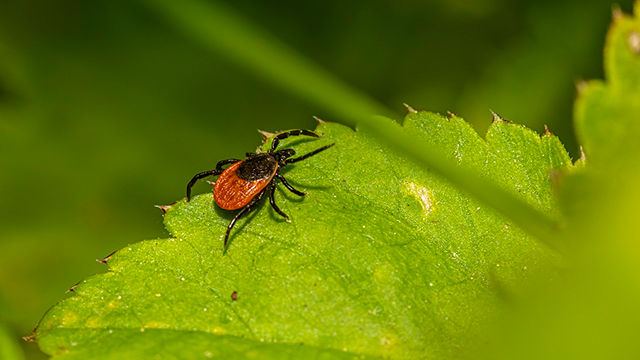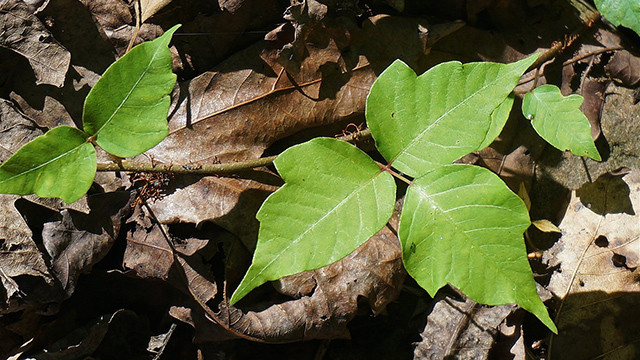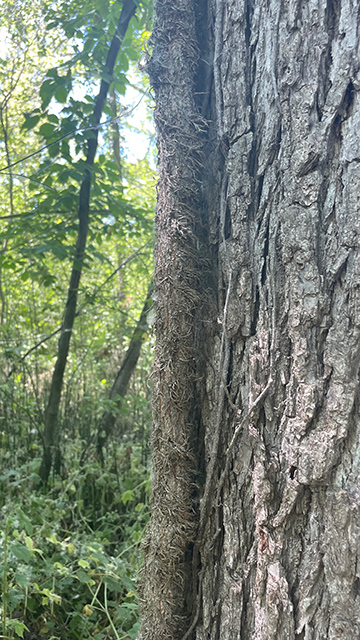Hazards
Point Pelee National Park
Ticks

The black-legged tick can be found at Point Pelee. Ticks throughout North America can carry Lyme disease. Lyme disease is a serious illness; however, it's easy to prevent and treat when caught early. Only approximately 20-25% of blacklegged ticks in most of Ontario are infected by Lyme disease, however this can be up to 50% in hot spots.
Where are ticks found?
- Ticks are typically found in woods or tall grasslands and are active when temperatures are as low as 4°C.
- Ticks cannot fly or jump – they hang onto small bushes or tall grasses and are usually found close to the ground.
- They wait for an animal or person to pass nearby and when they make contact, the ticks climb on and attach themselves to the skin to feed.
Tick contact and Lyme disease prevention
- Keep yourself and your leashed pets on designated trails to avoid contact with ticks.
- Wear protective clothing and avoid exposed skin. Tuck long pants into socks and wear closed-toed shoes.
- Wear light coloured clothing to make ticks appear more visible on you.
- Apply insect repellents containing DEET to both clothes and skin. Always read the label and follow instructions for use.
- Check for ticks on and under clothing, especially after being in areas where ticks may live.
- Keep a pair of fine tipped tweezers or a tick key and a small bottle of hand sanitizer handy for proper tick removal and treatment.
- Check areas including armpits, in and around hair, navel, groin, and behind the ears and knees. Also check children and pets. (A daily skin inspection greatly reduces the risk of infection as ticks may take several hours to two days to attach to the skin and feed).
- Wash clothes promptly and put them in the dryer with heat to help kill any ticks that may remain.
- Shower or bathe within two hours of being outdoors to wash away loose ticks.
What to do if a tick is crawling on you
- A tick needs to bite you to infect you. If you have just found a tick crawling on your clothing or skin, you are not at risk of Lyme Disease.
- If you find a tick crawling on you, drown it in rubbing alcohol to kill it.
What to do if a tick is embedded on you
- If the tick is embedded in your skin, use a tick key or tweezers to remove it. Ensure you remove the entire tick. Sterilize the area with rubbing alcohol and an over-the-counter topical antibiotic cream such as Polysporin.
- If a tick has been embedded for more than 24 hours, or you are unsure as to how long the tick has been there, go see your doctor to receive a treatment of antibiotics. Keep the tick and send it to the health unit for testing, or to take to your doctor.
For more information on Lyme disease, blacklegged ticks, and how to protect yourself from tick bites while enjoying the outdoors, please visit the following websites:
Public Health Agency of Canada - Facts about Lyme disease
Government of Ontario - Lyme disease
Poison Ivy

Poison ivy is a plant found in Point Pelee National Park that transfers an oily resin called urushiol to your skin upon contact. This causes an itchy rash or blisters. It is commonly found in and around woodlots, and along trails and roadsides. Point Pelee is home to three varieties of Poison Ivy (bush, plant, vine).
Identifying poison ivy:
Poison ivy can be identified by its clusters of three leaves, with the middle leaf having a longer stem than the two side leaves. The plant appears reddish in the spring, green in the summer, and red, orange, or yellow in the fall.

Where is poison ivy found?
- Growing along the edges of park trails in Point Pelee.
- In short patches close to the ground or as a vine that climbs up trees, shrubs, and posts.
Poison ivy contact prevention
- You can avoid contact with poison ivy by staying on the trail and keeping your dog on a leash to reduce the chance of the resin transferring from your pet's fur to your skin.
- Wear protective clothing and closed-toed shoes with minimal amounts of exposed skin.
What to do if you touch poison ivy?
- Lather with soap and rinse with cool water to remove the oily resin from skin.
- Try not to scratch at a rash. Rashes typically go away in 2 to 3 weeks.
- Date modified :